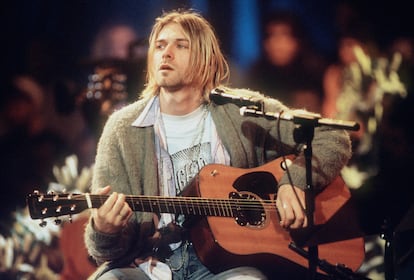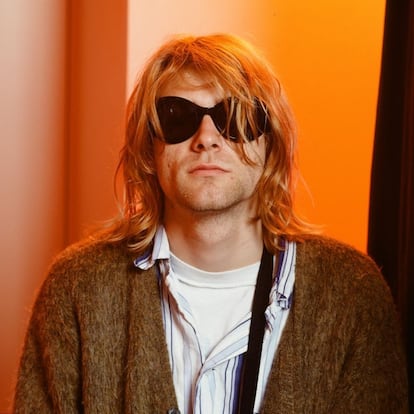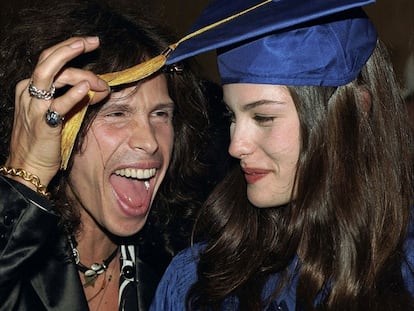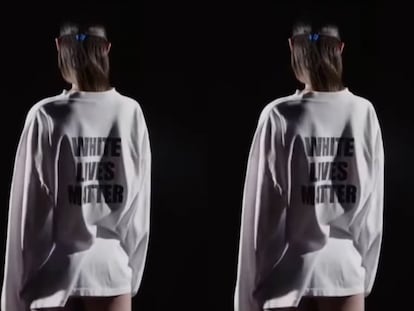Kurt Cobain: How a dirty secondhand cardigan became part of pop culture legend
The knitted wrap the Nirvana frontman wore to record the MTV Unplugged session has had several lives, from a gentleman’s weekend garment to an object of capitalist investment

The 1990s, or what we understand as the 1990s, have been resurrected so many times that almost every teenager with a Vinted or Depop account and Instagram access can make a list of the decade’s most iconic garments. It would include the Virgin Airlines sweatshirt that Lady Diana Spencer wore one day while leaving the gym, the checked miniskirt suit that Alicia Silverstone donned in Clueless and the combo metallic skirt and baby-sized Angora jersey that all the supermodels wore in the golden age of Versace. It would also feature Jennifer Aniston’s wedding dress from the Friends pilot, Aaliyah’s Tommy Hilfiger underwear and the modest pastel-colored cardigans that actresses wore over their spaghetti-strap dresses on the red carpet.
Among all those garments would also be the weathered cardigan that Kurt Cobain wore when he recorded MTV Unplugged with Nirvana. It is now the property of an anonymous buyer who picked it up for $334,000 in a 2019 auction at the New York auction house Julien’s. It was the second time that the sweater had been sold. The catalog described it as “a blend of acrylic, mohair and Lycra with five-button closure (one button absent), with two exterior pockets, a burn hole and discoloration near left pocket and discoloration on right pocket, size medium.” The seller, a Nirvana fan and the owner of a team of race cars, had acquired it four years earlier, also from Julien’s. At the time, he said that he had bought it not as an investment, but out of genuine devotion, and that the garment had “a special place in [his] heart.” After a few years of storing it in a safe in his Pennsylvania home, and likely after taking note of the growing market for rock memorabilia, he decided to put it up for sale. He used the proceeds to buy one of Cobain’s guitars during the same auction.
It ended up at auction because its previous owner, Jackie Farry, put it up for sale when she needed money. Farry had been the nanny of Cobain’s daughter, Frances Bean Cobain, and in the days after the Nirvana singer’s suicide she was one of the many people who passed through the house to console his wife, Courtney Love. Amid the confusion, the Hole singer removed objects from wardrobes to gift keepsakes to friends. Farry received the cardigan. The piece was already special. In addition to the MTV concert, Cobain had worn it often during the final months of his life. He used it as a sort of security blanket. Farry had always assumed she would keep the sweater for her entire life and later leave it to Frances Bean in her will, but after battling cancer for more than 11 years, without adequate medical insurance, Farry saw no option but to sell her most valuable possession. Before doing so, she consulted with Frances Bean and Love, who, she says, gave her their blessing and assured her that Cobain himself would have understood. With the proceeds from the garment - considerably more than she’d expected - she dreamed of building herself a swimming pool, but, she said, she ended up spending it all on rent and cancer treatment.

Grunge fashion takes the world by storm
The sweater could have been acquired for a few dollars in one of the many second-hand clothing stores in Seattle in the 1990s. It was made by the brand Manhattan Industries. According to fashion historian Kimberly Chrisman-Campbell, cited by Rolling Stone, it was likely made in the first half of the 1970s. The tag has a logo of a boat and a skier, as if to underline that it was a wealthy man’s leisure garment, the weekend wear of choice for a white-collar worker who, Monday to Friday, wore a gray flannel suit. After 1968, the male cardigan became associated in the American imagination with Mr. Rogers, the host of a children’s television show. He put on his own sweater, knit by his mother, in every episode, sometimes with the buttons crooked to show children that everyone makes mistakes. That association cemented the idea of the cardigan as a friendly piece of clothing, the incarnation of everything hygge and cozy.
Grunge fashion was full of irony: t-shirts with logos of commercial brands, worn to express rejection of consumerism; short dresses with plunging necklines reinterpreted as “kinderwhore”. But the adoption of the cardigan seems to be more of a practical decision than a reinterpretation: it’s cold in Seattle. The cardigan was worn with dirty Converse, flannel shirts, band t-shirts, plastic glasses bought at the supermarket and jackets from the 1950s and 1960s.
Cobain himself, who had a particular sense of style and a canonical physical beauty that is not often mentioned, as if it were incidental and not one of the factors behind Nirvana’s entry into the mainstream, contributed to changing the idea of anti-fashion grunge. If in its origins it was more influenced by the punk rock scene, including harder elements such as leather jackets, Cobain, who wore dresses before Harry Styles and Bad Bunny, moved that style towards androgyny. The angora cardigan fit well into that calculated slovenliness, with a soft fabric that has a long history in the men’s wardrobe but retains traces of women’s clothing.
1960s clothing, such as acrylic floral dresses, was easily found in thrift stores in the 1990s. Then, when the media started to cover the very local and small Seattle scene, regional garments, like the woolen hats and Pendleton flannel shirts worn in that area by loggers and other outdoor workers, as well as hiking boots and thermal underwear, spread to other climates. It was funny to see the young people of Los Angeles dressed as if they were cutting firewood in the state of Washington. As early as 1992, the first mention of “grunge” appeared in Women’s Wear Daily, the fashion industry magazine, along with the words “rave” and “hip hop.” That same year, Grace Coddington and Steven Meisel codified grunge in Vogue as “flannel shirts, worn-out band t-shirts, boots and baseball caps.” Naomi Campbell and Kristen McMenamy posed in kilts, Doc Martens and, with little subtlety, Nirvana T-shirts worn over long-sleeved undershirts. And in 1992 Marc Jacobs made his famous grunge collection for Perry Ellis, which got him fired and earned him a place in fashion history. From there, other designers such as Anna Sui, Calvin Klein and even Giorgio Armani appropriate the subculture style to sell at a mark-up.
The Marc Jacobs collection for Perry Ellis didn’t have oversized cardigans. Rather, Helena Christensen, Christy Turlington and Kate Moss wore tiny knitted cardigans with checkered slip dresses. Who knows whether cardigans one or two sizes too big were on the designer’s radar: Jacobs readily admitted that he had never even been to Seattle.
Cobain’s cardigan would enter pop culture legend a year later, in November 1993, when Unplugged was recorded in New York. For that concert, which introduced MTV’s then-stratospheric audiences to an acoustic version of the loudest band on the planet, Cobain mesmerized the cameras in a canonical version of the grunge uniform: a Frightwig T-shirt, grimy Converse, blue jeans and a toad-green cardigan with five buttons, one of them missing, and a cigarette burn.
Tu suscripción se está usando en otro dispositivo
¿Quieres añadir otro usuario a tu suscripción?
Si continúas leyendo en este dispositivo, no se podrá leer en el otro.
FlechaTu suscripción se está usando en otro dispositivo y solo puedes acceder a EL PAÍS desde un dispositivo a la vez.
Si quieres compartir tu cuenta, cambia tu suscripción a la modalidad Premium, así podrás añadir otro usuario. Cada uno accederá con su propia cuenta de email, lo que os permitirá personalizar vuestra experiencia en EL PAÍS.
¿Tienes una suscripción de empresa? Accede aquí para contratar más cuentas.
En el caso de no saber quién está usando tu cuenta, te recomendamos cambiar tu contraseña aquí.
Si decides continuar compartiendo tu cuenta, este mensaje se mostrará en tu dispositivo y en el de la otra persona que está usando tu cuenta de forma indefinida, afectando a tu experiencia de lectura. Puedes consultar aquí los términos y condiciones de la suscripción digital.
More information
Últimas noticias
Most viewed
- Oona Chaplin: ‘I told James Cameron that I was living in a treehouse and starting a permaculture project with a friend’
- Reinhard Genzel, Nobel laureate in physics: ‘One-minute videos will never give you the truth’
- Sinaloa Cartel war is taking its toll on Los Chapitos
- Why the price of coffee has skyrocketed: from Brazilian plantations to specialty coffee houses
- Silver prices are going crazy: This is what’s fueling the rally










































